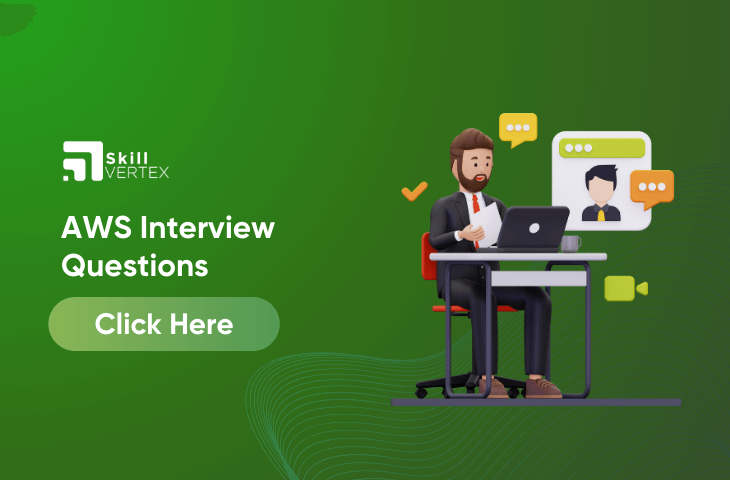1) What is AWS?
2) What are the components of AWS?
3) What are Key-pairs?
4) What is S3?
5) What are the pricing models for EC2 instances?
6) What is AWS Lambda?
7) How many buckets can be created in S3?
8) What is Cross Region Replication?
9) What is CloudFront?
10) What are Regions and Availability Zones in aws?
11) What are edge locations in aws?
12) What is the minimum and maximum size that you can store in S3?
13) What are EBS Volumes?
14) What is Auto Scaling?
15) What is AMI?
16) Can a AMI be shared?
17) What is an EIP?
18) What are the different storage classes in S3?
19) How can you secure the access to your S3 bucket?
20) What are policies and what are the different types of policies?
21) What are different types of instances?
22) What is the default storage class in S3?
23) What is a snowball?
24) Difference between Stopping and Terminating the instances?
25) How many Elastic IPs can you create?
26) What is a Load Balancer?
27) What is VPC?
28) What is VPC peering connection?
29) What are NAT Gateways?
30) How can you control the security to your VPC?
31) What are the different database types in RDS?
32) What is Redshift?
33) What is SNS?
34) What are the different types of routing policies in route53?
35) What is the maximum size of messages in SQS?
36) Differences between Security group and Network access control list?
37) What are the two types of access that you can provide when you are creating users?
38) What is subnet?
39) Differences between Amazon S3 and EC2?
40) Can you establish a peering connection to a VPC in a different region?
41) How many subnets can you have per VPC?
42) When EC2 officially launched?
43) What is Amazon Elasticache?
44) What are the types of AMI provided by AWS?
45) What is Amazon EMR?
46) How to connect EBS volume to multiple instances?
47) What is the use of lifecycle hooks in Autoscaling?
48) What is Amazon Kinesis Firehose?
49) What is the use of Amazon Transfer Acceleration Service?
50) How will you access the data on EBS in AWS?
51) Differences between horizontal scaling and vertical scaling?
AWS Interview Questions With Answers
- AWS (Amazon Web Services):
AWS is a comprehensive cloud computing platform provided by Amazon. It offers a wide range of services, including computing power, storage options, networking, databases, machine learning, analytics, security, and more. AWS allows businesses and individuals to access and use computing resources on a pay-as-you-go basis. - Components of AWS:
AWS is composed of numerous services. Some key components include:
- EC2 (Elastic Compute Cloud): Virtual servers in the cloud.
- S3 (Simple Storage Service): Object storage for the web.
- RDS (Relational Database Service): Managed relational databases.
- Lambda: Serverless computing service.
- VPC (Virtual Private Cloud): Networking service to create isolated environments.
- IAM (Identity and Access Management): Security service for managing users and their access.
3.Key-pairs:
Ans.Key-pairs in AWS are used for secure access to EC2 instances. It involves a public key, which is placed on the instance, and a private key that is kept secure. The private key is used to authenticate and securely connect to the EC2 instance.
4.S3 (Simple Storage Service):
Ans.S3 is an object storage service that offers industry-leading scalability, data availability, security, and performance. It is commonly used for storing and retrieving any amount of data from anywhere on the web. S3 allows you to store and retrieve any amount of data at any time.
5.Pricing Models for EC2 Instances:
Ans.EC2 instances are billed based on various pricing models, including:
- On-Demand Instances: Pay for compute capacity by the hour or second with no upfront cost.
- Reserved Instances: Provides a significant discount in exchange for a commitment to a one- or three-year term.
- Spot Instances: Allows you to bid for unused EC2 capacity at potentially lower prices.
- Dedicated Hosts: Physical servers dedicated for your use, offering additional visibility and control.
6.AWS Lambda:
Ans.AWS Lambda is a serverless computing service that lets you run your code without provisioning or managing servers. It automatically scales and executes code in response to triggers, such as changes to data in an S3 bucket, updates to a DynamoDB table, or HTTP requests via the API Gateway.
7.Number of Buckets in S3:
Ans.In Amazon S3, you can theoretically create an unlimited number of buckets per AWS account. However, there are practical limitations, and AWS recommends keeping the number of buckets to a reasonable minimum for easier management.
8.Cross Region Replication:
Ans.Cross Region Replication (CRR) is a feature in Amazon S3 that allows you to replicate objects across different AWS regions. This can be used for disaster recovery, low-latency access to objects, and compliance requirements.
9.CloudFront:
Ans.Amazon CloudFront is a content delivery network (CDN) service that securely delivers data, videos, applications, and APIs to customers globally. It integrates with other Amazon Web Services products to give developers and businesses an easy way to distribute content to end-users with low latency and high data transfer speeds.
10. Regions and Availability Zones in aws
Ans. Regions in AWS are separate geographic areas, like US East or Asia Pacific, each containing multiple availability zones (AZs). Availability zones are individual data centers within a region, isolated for fault tolerance. Users interact with the cloud through services provided by the cloud provider, deploying resources across AZs for high availability. Data centers house components like servers, switches, firewalls, and load balancers, enabling users to run applications and services in a secure and scalable manner. The design ensures redundancy, reliability, and optimal performance.
Hello, I’m Hridhya Manoj. I’m passionate about technology and its ever-evolving landscape. With a deep love for writing and a curious mind, I enjoy translating complex concepts into understandable, engaging content. Let’s explore the world of tech together

